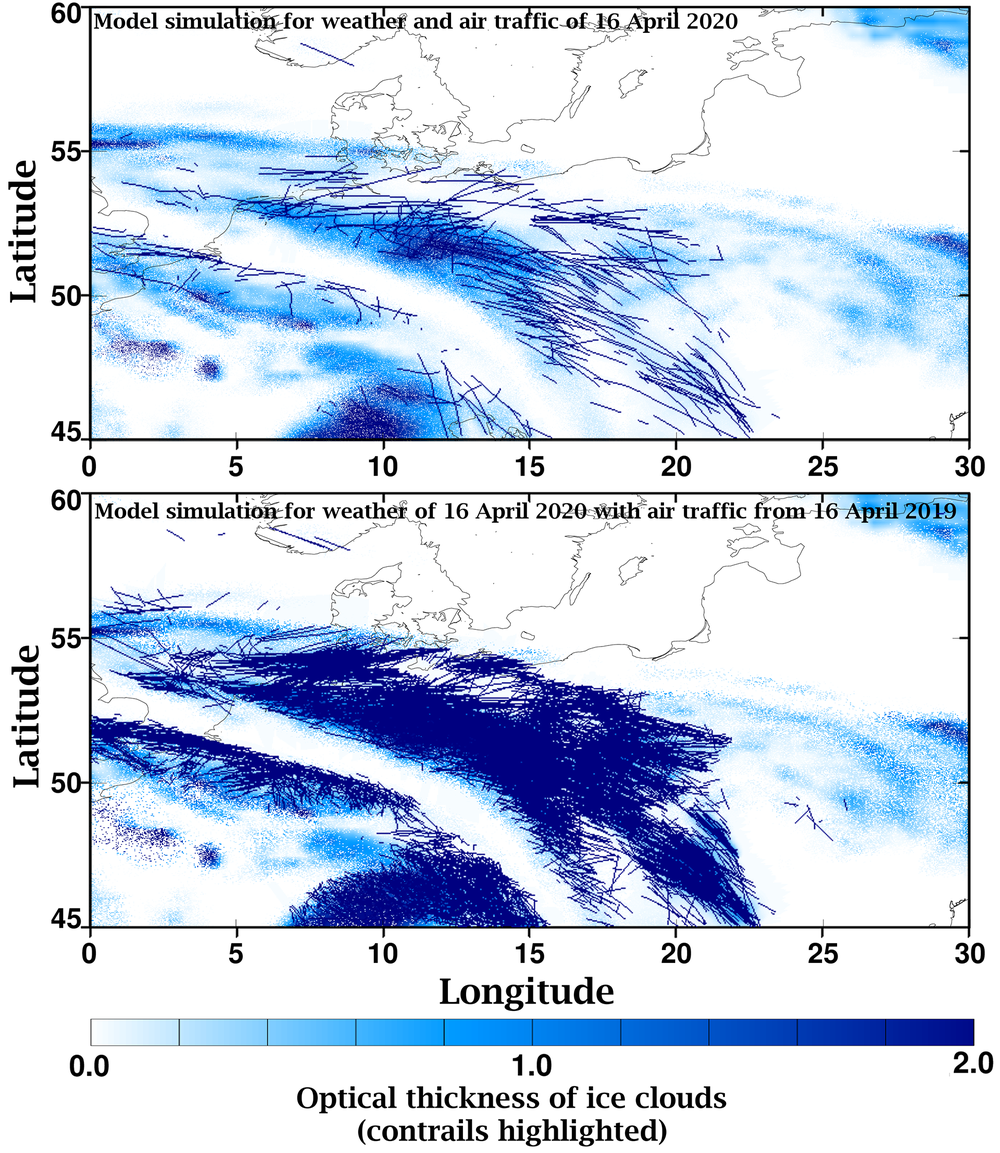Up to 90 percent fewer condensation trails due to reduced air traffic over Europe



- DLR has analysed the influence of reduced air traffic on contrails
- Air traffic over Europe was compared between 16 April 2020 and 16 April 2019
- Over the next few months, scientists will determine more precisely how the reduced contrail coverage will affect Earth's radiation budget in 2020
- Focus: Aeronautics, space, climate change
Travel restrictions put in place to stem the COVID-19 pandemic have led to a massive decline in global air traffic since mid-March 2020. The European air traffic control authority, EUROCONTROL has reported that the volume of European air traffic in April 2020 declined by almost 90 percent compared to the beginning of the previous month. Researchers at the German Aerospace Center (Deutsches Zentrum für Luft- und Raumfahrt; DLR) have now analysed the impact of reduced air traffic on the formation of condensation trails over Europe by measuring cloud properties. They used data acquired on 16 April 2020 by the ‘Spinning Enhanced Visible and Infrared Imager' (SEVIRI) sensor on a Meteosat Second Generation (MSG) weather satellite for this purpose. On that day, the atmosphere over Europe was cold and humid enough for long-lasting condensation trails to form behind aircraft. The analyses show a decrease in the number of contrails formed to about one tenth, compared to normal operations.
"Observations of the now-reduced condensation trail coverage allow us to verify the accuracy of the data analyses afforded by MSG weather satellites and the models that we use, so that we can determine the climate impact of condensation trails in greater detail in future," explains Christiane Voigt of the DLR Institute of Atmospheric Physics in Oberpfaffenhofen. "Since, in addition to carbon dioxide emissions, condensation trails are responsible for approximately half of the climate impact of air transport, we would expect that so little air traffic would result in a marked decrease in the climate impact." Regular global air traffic has hitherto been responsible for approximately five percent of global warming.
The researchers compared the satellite measurements with a model developed at the DLR Institute of Atmospheric Physics, which calculates the coverage made up of natural clouds and cirrus clouds produced by aircraft contrails, based on current air traffic movements and weather data. Luca Bugliaro and Ulrich Schumann from the DLR Institute of Atmospheric Physics explain: "The findings based on the satellite imagery were largely consistent with the model data, and the model reflects the regional structures and gives a good representation of the measured values of the optical thicknesses of clouds." In addition, the scientists used the model to calculate a scenario with an air traffic volume 10 times higher, as it would have been on the same day in 2019, with the meteorological conditions kept the same in order to pinpoint the effect of traffic levels alone. The calculations clearly show far greater coverage from contrail cirrus clouds, with an increased optical thickness of the ice clouds. Weighted with the optical thicknesses, the degree of coverage of the partially overlapping contrails would be four times greater.
Over the coming months, scientists want to determine more precisely how the reduced coverage due to contrails and the related cirrus clouds will affect Earth's radiation budget, using more satellite data and analyses. To do this, measures include comparing the thermal radiation emitted by Earth, measured from space, with the incident solar radiation. "In this special situation, when there is very little air traffic, we hope to be able to directly demonstrate the effect of the decrease in condensation trails on Earth's heat balance through a large number of measurements," explains Markus Rapp, Director of the DLR Institute of Atmospheric Physics.
Tiny ice crystals in cold air
Condensation trails consist largely of tiny ice crystals that form in cold air (at temperatures below approximately minus 42 degrees Celsius) from the exhaust gases of aircraft. First, water vapour condenses on soot particles in the exhaust gases, forming tiny water droplets. As they mix with the air, the droplets quickly cool and freeze to form ice crystals. If the surrounding air is sufficiently damp (oversaturated with ice), the ice crystals absorb water from their environment, grow, spread out and take on cloud-like shapes, which wrap around Earth like a scarf.
These contrail cirrus clouds keep some of the Earth's heat radiation within the atmosphere and thus have a warming effect on the climate. However, as they also reflect sunlight, they have a cooling effect at times. At present, the degree to which contrail cirrus clouds contribute towards the overall radiative forcing by air traffic is of a similar magnitude to the effect of carbon dioxide, which has been emitted by aircraft since the very beginning of aviation. Unlike carbon dioxide, which has a lifetime of over 100 years within the atmosphere, contrails usually dissipate within a matter of minutes or hours, so their climate impact is rapidly reduced if there is a decrease in air traffic. DLR is also investigating how contrails can be avoided by routing flights around areas of humid air.
Changes to the chemical composition of the atmosphere due to reduced air traffic are also to be researched during an upcoming aircraft mission with the Falcon and HALO research aircraft.
Related Links
Related News
- Climate model shows that cleaner aircraft emissions reduce the climate impact of contrail cirrus
- Climate impact of clouds formed from aircraft condensation trails could treble by 2050
- DLR/NASA research flights over northern Germany
- NASA and DLR investigate the impact of aviation on the climate - joint flight tests on alternative fuel emissions
- A journey through an exhaust plume – DLR flight tests for alternative fuels
- NASA and DLR: joint research flights using biofuel
- Research flights - DLR investigates the effect of contrails and volcanic emissions on the climate


